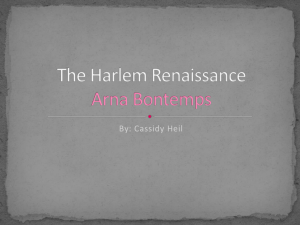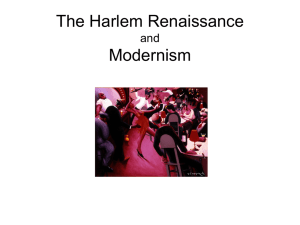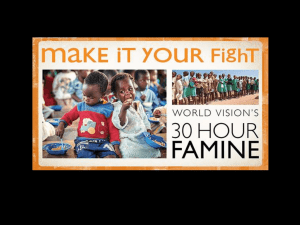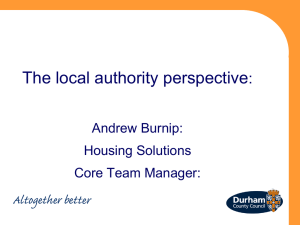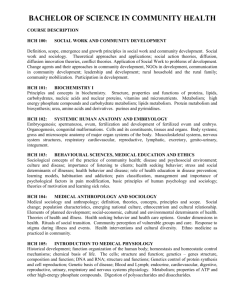Evaluation of Healthcare for the Homeless Program Impact on ER
advertisement
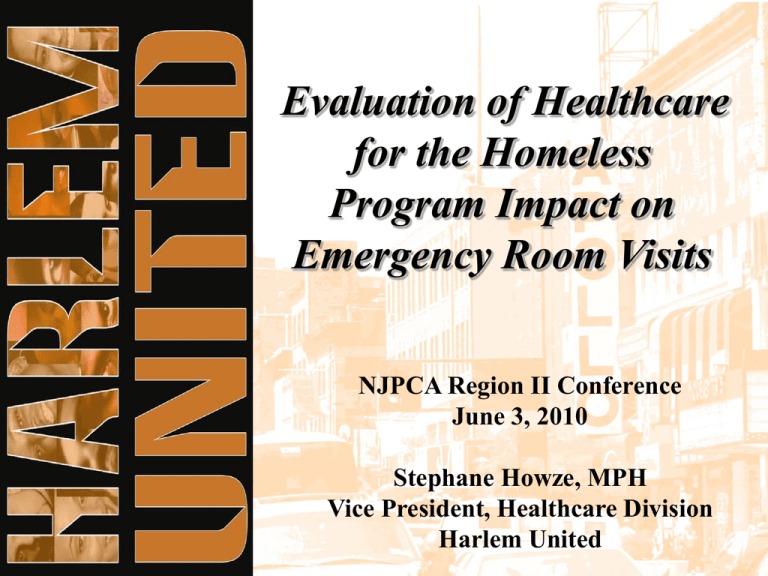
Evaluation of Healthcare for the Homeless Program Impact on Emergency Room Visits NJPCA Region II Conference June 3, 2010 Stephane Howze, MPH Vice President, Healthcare Division Harlem United Background • ER utilization has increased sharply nationwide (31% increase from 1995 to 2005).[1] • Homeless individuals account for a high portion of ER use; they are three times more likely than the general population to use the emergency department and tend to visit the ER repeatedly.[2]-[3] • Roughly 26% of New York City (NYC) populations live at or below 200% of the federal poverty line, with poverty rates being much higher in East and Central Harlem.[4] • Homeless individuals often have limited access to healthcare/primary care, have poor health status, and high rates of co-morbidities due to multiple barriers to quality healthcare 2 Harlem United’s Response • Integrated care Model - offer medical care that is truly integrated with other essential services in a culturally competent, supportive, healthy healing community that meets clients’ multiple needs • A “one-stop-shop” approach - allows members to benefit from a wide array of services in areas of medical and dental care, Mental Health services, expressive therapies, and case management. 3 Harlem United – Who We Are The Blocks Project Supportive Housing Programs •Innovative prevention initiative • Targets neighborhoods with high HIV prevalence, not high-risk sub-groups •HIV education, testing and connection to care •Additional social services via partners Case Management, Primary Care Support, Treatment Education, Mental Health Services, Substance Use Counseling, Advocacy, Structured Socialization FROST’D @ Harlem United HRA Housing (Scatter-Site) Supportive Housing Programs Women’s Housing (Scatter-Site) HUD Housing (Scatter-Site) ♦Injection Drug User Care ♦Harm Reduction ♦Syringe Exchange ♦Testing and Linkage to Healthcare Prevention Services Education and Training ♦HIV Education and Community Awareness events ♦African Immigrants Services ♦Black Men’s Initiative Transitional Housing (Scatter-Site) Emergency Congregate Housing (Foundation House North & South) Permanent Congregate Housing Building Bridges Mental Health Program Dental Clinic Federally Qualified Health Center & Related Services Medical Care, Adherence Support, Nutrition Counseling, Substance Use Counseling, Structured Socialization, Pastoral Care, Expanded Syringe Access Program Testing Services Primary Care (Westside & Eastside) Vocational Education Program Adult Day Health Center West Delivery of CDC-sponsored effective behavioral interventions ♦Healthy Relationships ♦Many Men, Many Voices ♦Youth Space Adult Day Health Center East Healthcare for the Homeless COBRA Case Management Fully Bilingual (Spanish/English) Case Management, Treatment Education, Support Groups, Harm Reduction Counseling, Auricular Acupuncture, Primary Care Support Healthcare & related services for the homeless in Central & East Harlem Assessment, Intensive Case Management, Advocacy, Crisis Intervention ♦Rapid HIV testing ♦Innovative recruitment strategies ♦Evaluation of testing strategies ♦Connection to primary care services ♦Access to HIV care through ADAP enrollment ♦ Uptown Health Link Evening Food & Nutrition Nutritional Assessment and Support, Treatment Education, Psycho-Social Support Mental Health Services Crisis Intervention, Individual and Group Psychotherapy, Medication Management, Expressive Therapies 4 Harlem United - What We Do • Founded at height of first phase of AIDS epidemic: 1988. • In the early development, Harlem United (HU) specifically served people living with HIV/AIDS (PLWH/As) who were homeless and/or suffering from mental illness and/or substance use. • Agency of last resort for medically-underserved communities of color in Harlem. • Part of community-based movement to care for PLWH/As: Founded to address lack of response from established providers; Responding to the unique personal, social, and institutional barriers to care in Harlem. 5 Harlem United – Healthcare Division ADHC Article 28 License 1997 Primary Care Amendment to Article 28 License 2000 Dental Amendment to Article 28 License 2003 El Faro Extension Clinic Open ADHC & PC 2006 FQHC Designation Homeless 2007 Psychological Services Amendment to Article 28 License 2009 CENTER OF EXCELLENCE MANAGING CHRONIC ILLNESS 2012 ALL VULNERABLE HIV FOCUSED PATIENTS WITH A ALL VULNERABLE MULTIPLICITY OF PATIENTS WITH A NEEDS MULTIPLICITY OF NEEDS 6 Harlem United – Healthcare & Related Services Federally Qualified Healthcare Center Healthcare services for the Homeless in Central and East Harlem Adult Day Health Center East Adult Day Health Center West Medical Care, Adherence Support, Nutrition Counseling, Substance Use Counseling, Structured Socialization, Pastoral Care Community Case Management Assessment, Intensive Case Management, Advocacy, Crisis Intervention; VidaCare Case Management; Maintenance in Care Primary Care Dental Clinic Healthcare & Related Services Evening Food & Nutrition Nutritional Assessment and Support, Treatment Skillsbased Education, Psycho-Social Support and Harm Reduction Fully Bilingual (Spanish/English) Case Management, Treatment Education, Support Groups, Harm Reduction Counseling, Auricular Acupuncture, Primary Care Support Wellness Center Mental Health and Substance Use Services Crisis Intervention, Individual and Group Psychotherapy, Medication Management, Expressive Therapies 7 FQHC – Healthcare for the Homeless (HCH) • The FQHC-H designation allowed us to expand services to homeless people in Central and East Harlem communities who are predominantly African American and Latino(a) adults, and have histories of substance use and/or mental illness. • This shift is very much aligned with our original mission; both our traditional clients and our new homeless clients are primarily poor, Africa American and Latino(a) adults, have histories of substance use and/or mental illness. All have experienced problems accessing medical care and supportive services. 8 HCH Services – An Integrated Care Model Dental Clinic - Diagnostic X-rays and Exams - Preventive Care - Emergency Care - Restorations -Endodontics -Prosthodontics -Periodontics - Oral Surgery - Referral to outside specialists for complex Surgical Procedures Mental Health and Substance Use Services Crisis Intervention, Individual And Group Psychotherapy, Medication Management, Expressive Therapies Primary Care clinic (Westside & Eastside) Federally Qualified Health Center GYN, Health Education, Directly Observed Therapy, Psychiatry services, Preventive Health Services, Management Of Chronic Conditions Other services Referrals, Outreach, and Case Management. 9 HCH Goals • To increase access and eliminate barriers to care for homeless individuals in Central and East Harlem neighborhoods • To improve health outcomes of homeless individuals • To triage homeless individuals in Central and East Harlem neighborhoods from Emergency Room to our FQHC through HCH program 10 Evaluating HCH Efficacy An outcome study was conducted in 2009 to evaluate HCH efficacy Study Question: Are there differences in frequency of ER visits among homeless clients who have been receiving HCH services and those who are new to HCH? 11 Method Study Design: Cross-sectional study Outcome variable: Frequency of ER visits Sample - Baseline group: new HCH clients who had their first intake between January 1 – December 31, 2009 - Follow up group: clients who have been receiving services provided by HCH, indicated by having at least two HCH visits between January 1 – December 31, 2009. Analysis T-test to determine whether or not there are any differences in frequency of ER visits among clients in baseline and follow-up groups 12 Results – Demographics distribution Both groups have similar demographics distribution % of clients Age distribution 50% 45% 40% 35% 30% 25% 20% 15% 10% 5% 0% 45% 48% 38% 29% Baseline Follow-up 14% 9% 8% 6% 0% 0% <26 26-39 40-54 Age group 55-69 >70 13 HCH: –Diagnostic Results Diagnosis Distribution distribution Both groups have similar chronic illness distribution 14 Results – Frequency of ER visits Despite the similar demographics and chronic illness distributions, we observed a significant difference in the number of ER visits among the baseline and follow up groups. Average number of ER visits per person Frequency of ER Visits in baseline and follow up groups 0.7 0.6 0.5 0.4 0.3 0.2 0.1 0 Baseline Follow up Groups 15 Results – Frequency of ER visits The difference in frequency of ER Visits among the baseline and follow-up groups could be attributed to comprehensive HCH interventions, as evident in the following findings: Percentage of clients Distribution of services received among clients in the follow up group 120% 100% • 33% are also engaged in Dental 80% 60% 40% •100% of clients in the follow up group are engaged in Primary Care (PC) 100% 20% 33% 30% Dental Other services 0% PC •30% are engaged in other types of services, such as COBRA Case Management, ADHC, Maintenance in Care, and Mental Health Types of services 16 Results – Frequency of ER visits • Clients in the follow-up group have an average of three follow-up visits in 2009. The visit types range from: - PC follow-up - psychiatric visits - walk-in to get sick care - psychotherapy visits - etc • Many of those visits would have been made to the Emergency Room had they not been engaged in HCH. 17 Conclusions • Despite the absence of longitudinal analysis, findings may be regarded as preliminary evidence of HCH efficacy in triaging homeless patients from ER to HCH • The convenience of our integrated care model, the culturally appropriate safe atmosphere that we create and the way we treat clients with dignity and respect are what made the homeless population, despite their transient nature, come back to seek care and comfort in our clinic instead of utilizing the expensive Emergency Room. 18



